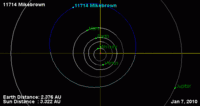11714 Mikebrown
| Discovery [1] | |
|---|---|
| Discovered by | LONEOS |
| Discovery site | Anderson Mesa Stn. |
| Discovery date | 28 April 1998 |
| Designations | |
| MPC designation | (11714) Mikebrown |
Named after |
Michael E. Brown (minor planet discoverer)[2] |
|
1998 HQ51 · 1977 RX8 1986 TH5 · 1986 TW10 1986 UR1 | |
|
main-belt [1] · (central) background | |
| Orbital characteristics [1] | |
| Epoch 4 September 2017 (JD 2458000.5) | |
| Uncertainty parameter 0 | |
| Observation arc | 38.94 yr (14,224 days) |
| Aphelion | 3.3555 AU |
| Perihelion | 1.9897 AU |
| 2.6726 AU | |
| Eccentricity | 0.2555 |
| 4.37 yr (1,596 days) | |
| 67.558° | |
| 0° 13m 32.16s / day | |
| Inclination | 3.0156° |
| 178.73° | |
| 135.17° | |
| Physical characteristics | |
Mean diameter | 4.451±0.945 km[3] |
| 0.246±0.069[3] | |
| 14.1[1] | |
|
| |
11714 Mikebrown, provisional designation 1998 HQ51, is a stony background asteroid from the central region of the asteroid belt, approximately 4.5 kilometers (2.8 miles) in diameter. It was discovered on 28 April 1998, by astronomers of the Lowell Observatory Near-Earth Object Search (LONEOS) at the U.S. Anderson Mesa Station near Flagstaff, Arizona, and later named after American astronomer Michael Brown.[2][4]
Orbit and classification

Mikebrown is a non-family asteroid from the main belt's background population. It orbits the Sun in the central main-belt at a distance of 2.0–3.4 AU once every 4 years and 4 months (1,596 days). Its orbit has an eccentricity of 0.26 and an inclination of 3° with respect to the ecliptic.[1]
On 15 May 2012, Mikebrown came within about 14.8 Gm (0.099 AU) of asteroid 625 Xenia.[5]
It was first observed as 1977 RX8 Palomar Observatory in 1977, extending the body's observation arc by 21 years prior to its official discovery observation at Anderson Mesa.[4]
Naming
This minor planet was named after American astronomer Michael E. Brown (born 1965), a professor of astronomy at Caltech in California, and best known for his discoveries of trans-Neptunian objects, in particular the dwarf planet 136199 Eris. The official naming citation was published on 24 July 2002 (M.P.C. 46104).[6]
Physical characteristics
According to the survey carried out by NASA's Wide-field Infrared Survey Explorer with its subsequent NEOWISE mission, Mikebrown measures 4.451 kilometers in diameter and its surface has an albedo of 0.246, which is typical for stony S-type asteroids.[3]
It has an absolute magnitude of 14.1.[1] As of 2017, no rotational lightcurve of Mikebrown has been obtained from photometric observations, and the body's rotation period and shape remains unknown.[1][7]
References
- 1 2 3 4 5 6 7 "JPL Small-Body Database Browser: 11714 Mikebrown (1998 HQ51)" (2016-08-18 last obs.). Jet Propulsion Laboratory. Retrieved 5 July 2017.
- 1 2 Schmadel, Lutz D. (2007). Dictionary of Minor Planet Names – (11714) Mikebrown. Springer Berlin Heidelberg. p. 767. ISBN 978-3-540-00238-3. Retrieved 25 April 2017.
- 1 2 3 Masiero, Joseph R.; Mainzer, A. K.; Grav, T.; Bauer, J. M.; Cutri, R. M.; Dailey, J.; et al. (November 2011). "Main Belt Asteroids with WISE/NEOWISE. I. Preliminary Albedos and Diameters". The Astrophysical Journal. 741 (2): 20. arXiv:1109.4096. Bibcode:2011ApJ...741...68M. doi:10.1088/0004-637X/741/2/68. Retrieved 25 April 2017.
- 1 2 "11714 Mikebrown (1998 HQ51)". Minor Planet Center. Retrieved 25 April 2017.
- ↑ "Mikebrown close approaches less than 15Gm". Archived from the original on 2012-02-25. Retrieved 2010-01-29. (Solex 10) Archived 2009-04-29 at WebCite
- ↑ "MPC/MPO/MPS Archive". Minor Planet Center. Retrieved 25 April 2017.
- ↑ "LCDB Data for (11714) Mikebrown". Asteroid Lightcurve Database (LCDB). Retrieved 25 April 2017.
External links
- Asteroid Lightcurve Database (LCDB), query form (info)
- Dictionary of Minor Planet Names, Google books
- Asteroids and comets rotation curves, CdR – Observatoire de Genève, Raoul Behrend
- Discovery Circumstances: Numbered Minor Planets (10001)-(15000) – Minor Planet Center
- 11714 Mikebrown at AstDyS-2, Asteroids—Dynamic Site
- 11714 Mikebrown at the JPL Small-Body Database
